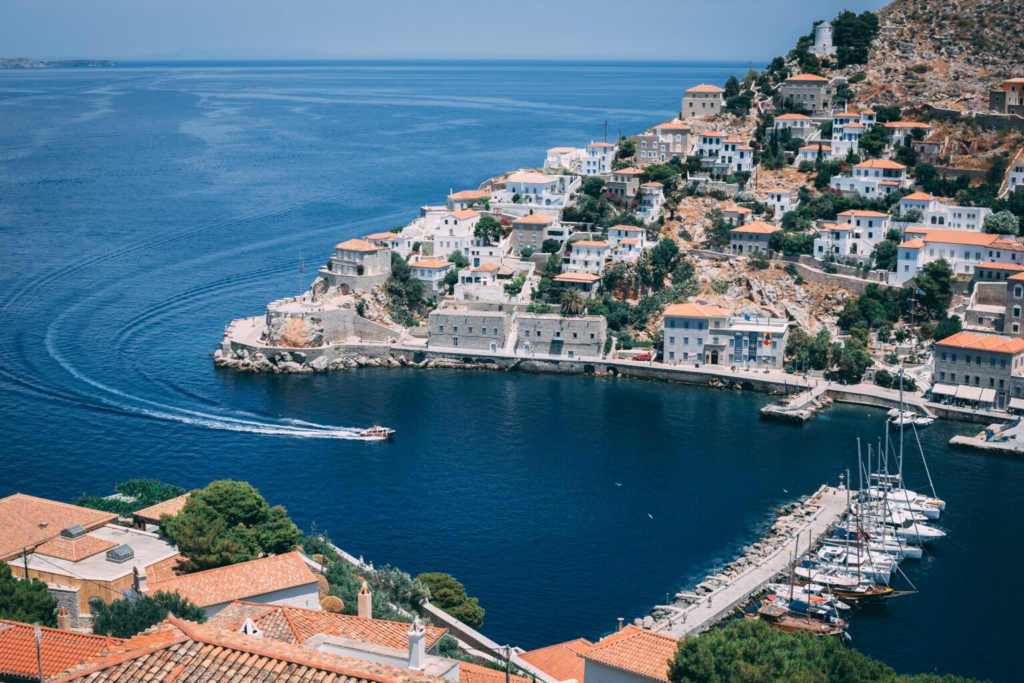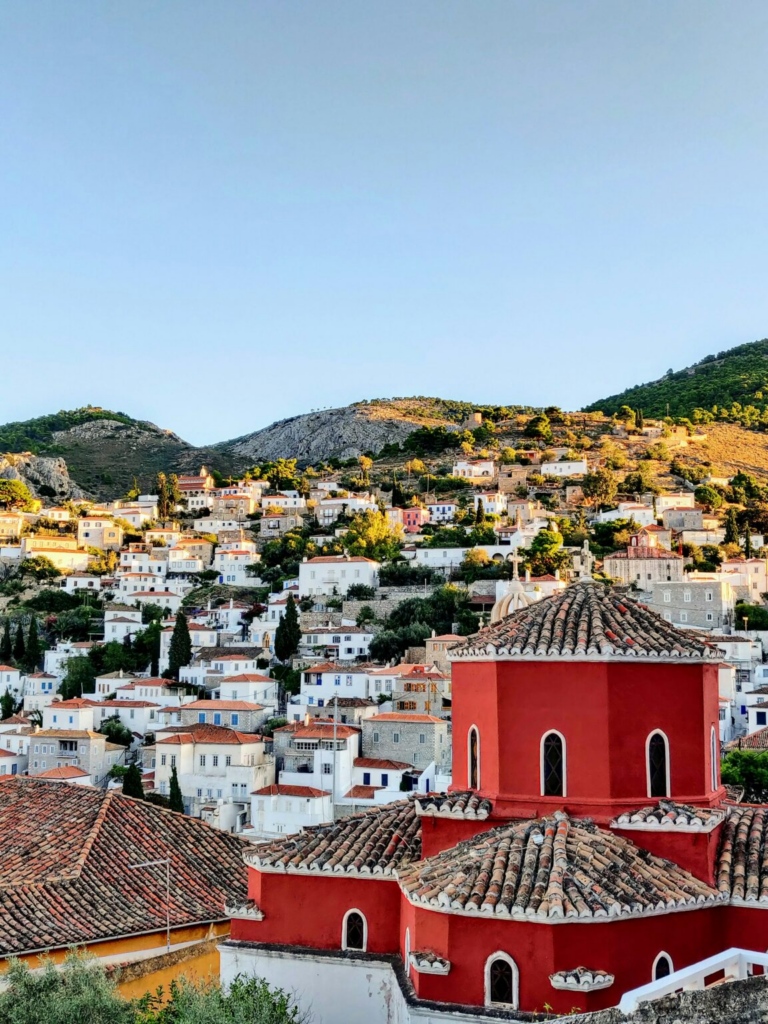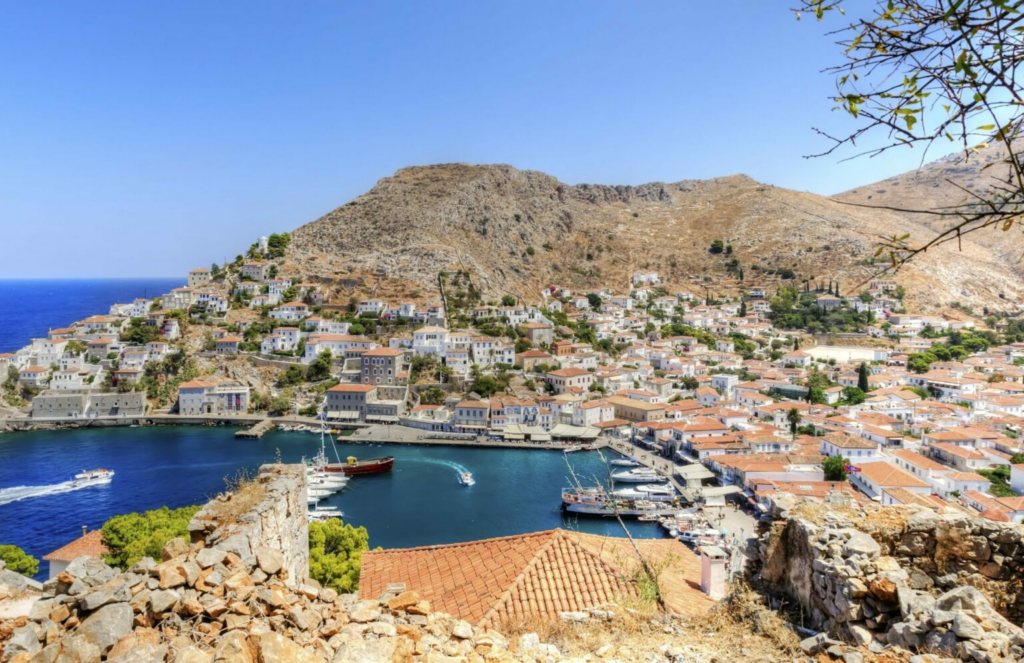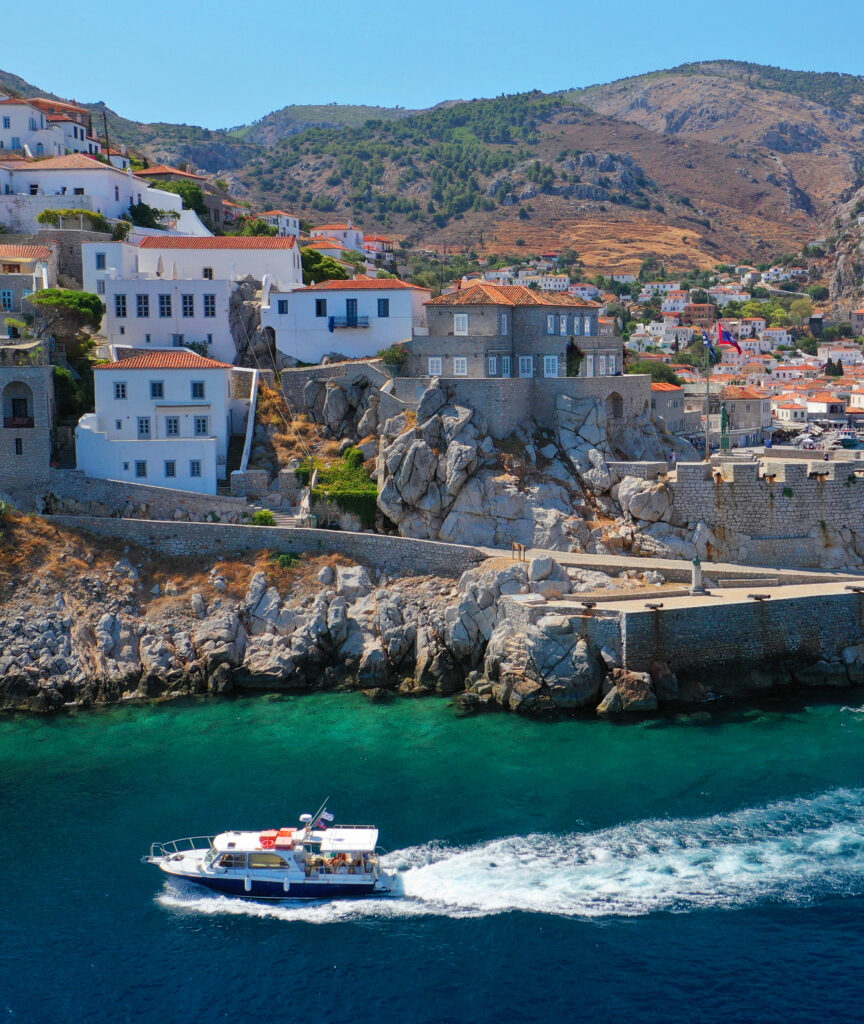A short sea journey takes you through time, shifting centuries, images, and habits. You gaze and gaze at the amphitheater-like settlement— a jewel with great historical and architectural heritage. You forget the sound of cars. You walk and keep walking, trying to familiarize yourself with the harbor, the promenade, the neighborhoods, the alleys, and the small squares, and then up to KIAFA. You greet the locals. You sneak peeks through the few open windows into the interiors of the mansions and the captains’ houses built at the end of the 18th century and the beginning of the 19th century, during Hydra’s economic prosperity thanks to its fleet. It was then that the well-traveled Hydriots brought back knowledge, experiences, money, and various valuable objects.

Thirty mansions and three hundred captains’ houses from those times adorn the settlement. Built with gray stone from Hydra and Dokos, wood, and tiles, with colorful doors and windows framed in white, they bask in the touch of the autumn sun. As simple and austere as they are on the outside, the high-ceilinged salons and their rooms were richly decorated, as you will see when entering hotels housed in former mansions and the museums of Lazaros and Pavlos Konturiotis. Ceiling frescoes and wall paintings. Marble floors with geometric patterns. Expensive rugs, luxurious furniture, and antiques. Decorative objects and elaborate tableware—all brought from various ports of the Mediterranean, transforming the spaces into Genoese mansions of the Renaissance. It makes you imagine the soirées that took place in the music and dance halls, attended by the “good society” of Hydra.

Hydra: A Stroll through the Harbor with Great Sights
A unique settlement with uneven three or four-story houses and secret gardens boldly faces the sea, whispering along with the sea breeze stories of glory, seamanship, wars, destructions, and triumphs. Stories of Sophia Loren, who made Hydra famous in 1950 with the film “The Boy and the Dolphin,” and all the celebrities who passed through here between 1960-70, creating their own VIP community, “the St. Tropez of the Argosaronic.” Legendary names like Lennon, Clapton, Rolling Stones, Onassis, Callas, Jackie O, Melina Mercouri, Dassin. And of course, Hydra’s friend Leonard Cohen, who has his own house on the island, marked on Google Maps. In addition to them, the island’s charm, home to Milto Sachtoyri, attracted people of spirit and arts like Chatzikyriakos-Gikas, Seferis, Eggonopoulos, Henry Miller, Tetsis.

A lively social life, mild and without the wild parties of past decades, still exists. Gallery openings, summer festivals, conferences, weddings, and events fill the harbor with yachts, while the cobbled streets buzz with faces dedicated to the world of business and celebrities. Many Greek and foreign entrepreneurs have invested in Hydra, restoring old mansions to turn them into summer residences.
However, the echoes of summer have faded on this November morning as I embark on my small trip to Hydra. Now, around me unfolds the everyday life of the locals. In the greengrocers and grocery stores of the main narrow street and at the Kastro-Dimarcheio, people come and go. Locals sip their coffee along the promenade, reflecting on the summer and sharing news of the day. Shops and restaurants prepare to close for winter, while others that will remain open get ready for lunchtime and evening.

I head to the eastern edge of the promenade, to the statue of Miaoulis, where one of the two bastions with cannons stands. The statue was erected in 1993, and the famous gunner’s remains were transferred to Hydra in 1985. I gaze at the settlement from this side and slowly return toward the harbor center, passing the twin Venetian buildings that once served as a hospital and powder magazine. Today, one houses the Melina Mercouri Municipality’s art and concert hall, and the other is the harbor office.
Kamini and the Museums
After passing the small beach of Avlaki, I continue along the beautiful path toward Kamini. There lies another stunning architectural complex of houses, many of which are villas for vacationing, rented apartments, and small hotels. Kamini’s larger and smaller beaches, along with the Castello, are very popular in summer when various taverns operate here.

This settlement began to be built alongside the harbor, as residents descended from the old neighborhood of KIAFA near the sea. It is believed to have taken its name when potters from Sifnos settled here with their kilns. The emblem of Kamini is the old house of the Miaoulis family, known as the “Red House,” built in 1786. Scenes from movies like “The Boy and the Dolphin” or “Mermaids and Men” were filmed here in the past, and for a time, it was rented by the Verena Foundation.

I return toward the harbor and turn right onto A. Lignou to reach the museum of Lazaros Konturiotis, in a beautiful house dating back to the late 18th century. It operates as a branch of the National Historical Museum, having preserved its historical and architectural features while shaping the exhibition spaces. It houses furniture, utensils, paintings, and personal items from the family, along with exhibits from the folklore collections of the National Historical Museum. In the old cellars, works by Pericles Byzantine and his son Konstantinos are displayed.

Climbing to KIAFA
Hydra’s settlement began in 1460 with the arrival of refugees, continuing through the 16th and 17th centuries. Initially, they settled in the area of Prophet Elias and later in KIAFA, where, once the dangers of raids passed, people descended to the sea, gradually building the present settlement. KIAFA has defensive features, high stone walls, and narrow alleys. It was inhabited almost continuously, except during the 1940s when many residents left the island and several houses were abandoned.

I climb up and explore the labyrinthine neighborhood with greengrocers, grocery stores, and carpentries operating in the main street. I am drawn to the beautifully painted churches of Saint John the Abstinent, considered one of the oldest on the island, with 17th-century frescoes, Saint Paraskevi—near which there is an excellent viewpoint of the harbor from above—and the private church of the Three Hierarchs. At the top stands Saint Constantine the Hydriot.

I continue to navigate the alleys with their canopied “passages” connecting the houses. Many are painted in bright colors, adding a cheerful note to the settlement. Conversations in various languages resonate from windows and courtyards, as many are rented out to foreigners, as I learn from chatting with the locals.

Descending again toward the harbor to catch the last speedboat of the day, I admire the Hydriot settlement, designated a Historical Site and protected as a Traditional area (the entire island is designated as a Landscape of Particular Natural Beauty). I am glad because I know that interventions and haphazard building cannot occur here. Thus, every time we come, we enter this microcapsule that safeguards the works of people and the aura of the rich history of this unique place in Greece, making us forget the noisy life of the cities.

Ask me anything
Explore related questions





